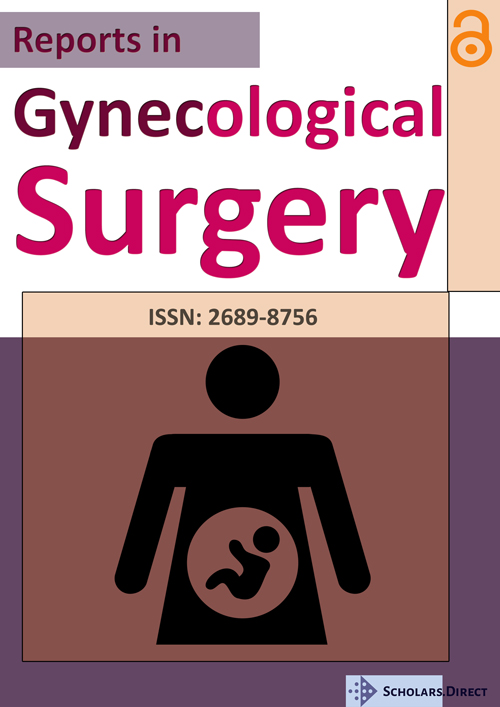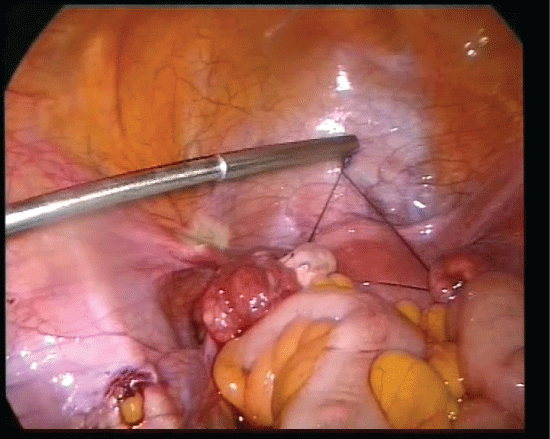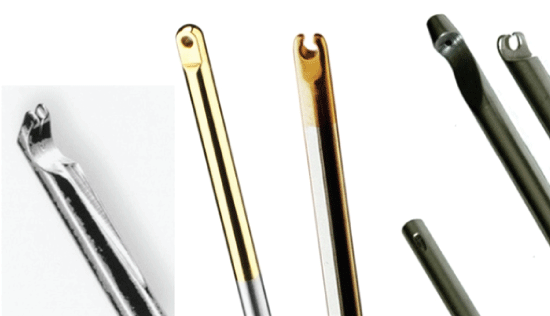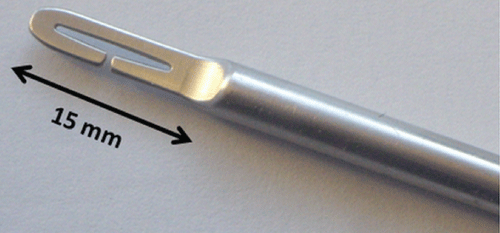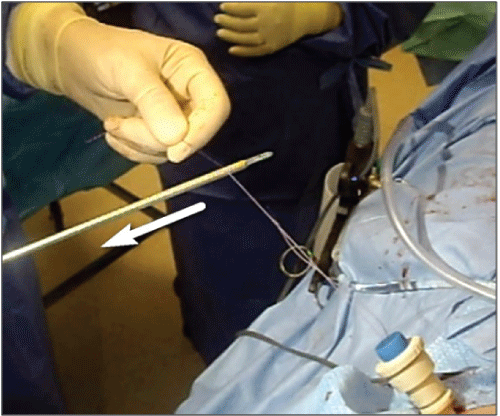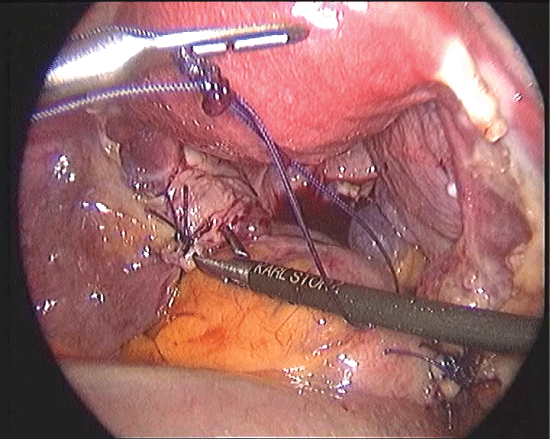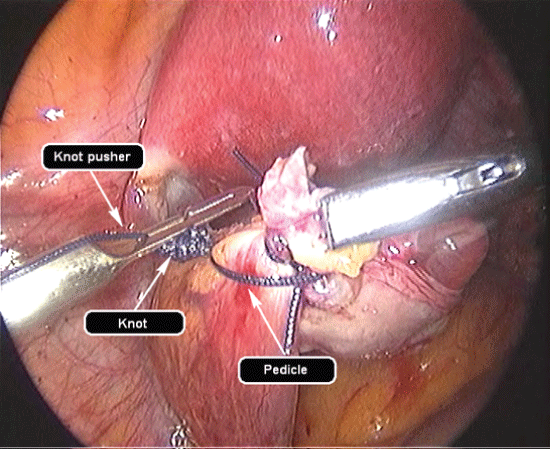The "Easy Load" Universal Knot Pusher: One Knot Pusher, Any Knot
Abstract
We describe a novel laparoscopic knot pusher which has the advantage over existing instruments of being suitable for applying both sliding and non-sliding extra-corporeal knots. Loading the suture into the knot pusher is done by touch rather than vision which is an advantage in a darkened endoscopy theatre, and once loaded, the suture is held securely despite not having had to thread the suture through a small eye. The knot pusher can also be used as an alternative to pre-tied Endoloops using a long tie. We have used the Easy Load Knot Pusher in over 50 gynaecological laparoscopic procedures and found it easy and convenient. There is no reason why the knot pusher should not be suitable for other endoscopic specialities and in other cavities.
The ability of repair tissue and prevent and control bleeding is fundamental to safe and effective surgery by any route, including endoscopy. Tissue repair is almost always done with sutures. While several modalities are available for hemostasis, such as electrodiathermy, clips, staples and high frequency ultrasound, in many instances suturing remains the safest and most versatile technique, especially when operating close to vital structures [1].
It was Kurt Semm, Professor of Obstetrics and Gynecology in Kiel, German, who in the late 1970s revolutionised laparoscopy when he developed techniques for suturing and described the elegant pre-tied Endoloop and various methods of extra- and intra-corporeal knot tying [2]. Procedures which formerly could only be done by laparotomy, such as myomectomy, suddenly became possible. Semm, for instance, was the first to carry out appendicectomy laparoscopically using an Endoloop to ligate the base of the appendix [3]. Endoscopic suturing has since been adopted by many surgical specialities.
Although considerably simpler to use than extra- or intra-corporeal suturing, loop ligation with pre-tied sutures is only suitable when there is a free pedicle to tie. In many situations, such as when using a needle suture to ligate a vessel, repair tissue or close an incision, the surgeon has to tie a knot either outside or inside the body (extra- or intra-corporeal suturing respectively). Of the two, extra-corporeal suturing is technically easier and can be applied when space is restricted.
Many extra-corporeal knots suitable for endoscopic surgery have been described over the years, and they can be broadly classified as sliding knots and flat knots (Table 1). Semm adapted the Roeder knot used for tonsillectomy both for the Endoloop and for extra-corporeal suturing, and this has become a standard sliding knot for gynecologists [2]. Several other sliding knots have since been adapted for endoscopy, orthopedic surgeons being particularly prolific in this field [4]. The alternative to sliding knots are the non-sliding flat knots, the choice of suturing technique generally being a matter of personal preference and the clinical situation.
Whether a sliding or non-sliding knot is used, a knot pusher is required to push any extracorporeal knot on to the target pedicle at endoscopy. In the case of sliding knots, the complete knot is tied extra-corporeally before the finished knot is pushed inside, whereas with non sliding knots, each throw is pushed in and tightened individually. The difference in configuration of the knots and their application has led for the need to have different knot pushers for sliding and non-sliding knots. Again, Semm was the pioneer with his original sliding knot pusher (Figure 1), but many other devices are now available for both types of knots (e.g. Clarke-Reich, Tulandi, SWEC-Carlton, Agarwal-Gaur) (Figure 2).
Currently available knot pushers, however, have a number of limitations. Firstly, they can secure either sliding knots or flat knots but not both. Secondly, closed ended knot pushers can be awkward to use when this involves having to thread the suture through a small eye, particularly so in a darkened endoscopy operating theatre. Thirdly, open ended knot pushers, which includes Semm's original knot pusher, can easily disengage from the suture before the knot has been fully tightened.
To overcome the limitations of existing knot pushers for extra-corporeal suturing, we designed a universal knot pusher which we have been using routinely since 2010 in over 50 gynecological laparoscopic procedures such as myomectomy, hysterectomy, oophorectomy, salpingectomy, ovarian reconstruction after cystectomy, adhesiolysis and ovarian suspension. The "Easy Load" Universal Knot Pusher is 40 cm (15 ¾ inches) long and 4.5 mm in diameter and can be used through a standard 5 mm laparoscopic port. It is made of high grade surgical steel and is reusable. The unique feature of the knot pusher is the 15 mm tip which has been designed specifically to circumvent the limitations of existing knot pushers (Figure 3 and Figure 4). Firstly, the knot pusher is suitable for applying both sliding and non-sliding knots; once the suture has been loaded into the tip, the knot pusher can be slide in as often as required. Secondly, loading the suture into the knot pusher is done by touch rather than vision by simply sliding the shaft of the pusher over the suture, much like a bow on a violin string (Figure 5). Thirdly, once loaded, the suture is held securely despite not having had to thread the suture through a small eye. The knot pusher can also be used as an alternative to pre-tied Endoloops; we use a 150 cm long tie to fashion a loop by tying a slip knot, and then use the knot pusher to hold and apply the loop over the pedicle before tightening the knot just as with a commercial product (Figure 6).
Two of the authors (IT and AM) and several junior doctors assistants have used the "Easy Load" Universal knot pusher and have found it easy and convenient to use and equally suited for tying sliding and flat knots. We have not had any complications related to the use of the device. The ability to load the suture quickly and easily in a darkened operating theater has been a particular advantage. In the case of the surgeon's knot, we prefer to start with two half hitches separately and in the same direction and push each throw onto the pedicle individually (1 = 1 = 1 = 1) rather than applying two half-hitches together (2 = 1 = 1) to avoid the knot from locking loose. Whichever type of knot is being applied, we have learnt that it is important to keep the knot which is being tightened between the knot pusher and the pedicle to avoid locking the knot pusher into the suture (Figure 7). Although not designed specifically for this indication, being able to use the knot pusher to apply loop ligatures prepared from a tie has proved an added bonus as this represents a considerable financial saving compared with commercially available pre-tied Endoloops. In the UK, for instance, a box of 6 ready-made endoloops (e.g. Surgitie™ Loop with Polysorb™ Suture, Covidien Surgical, UK) costs over £100 ($152 or €135), whereas a box of 36, 150 cm No 1 Polysorb ties (Syneture, US) is half the price; as up to 5-6 loop ligatures can be made from each 150 cm suture, the cost per endoloop can be as little as 23 pence ($0.35 or €0.31) compared with more than £15 ($23 or €20) for the commercial product. Not only is there a large saving in cost, but unlike ready-made Endoloops which have a fixed dimension, a loop tied this way can be prepared to any size making it suitable for any size of pedicle, even ones which are too large for the commercial product.
Although we have only used the knot pusher at gynecological laparoscopic procedures, there is no reason why this knot pusher should not be suitable for other specialities (e.g. GI, hepatic and renal laparoscopic surgery) or in other surgical areas such as arthroscopy, ENT surgery, and thoracoscopy. The knot pusher may also prove useful at conventional surgery when access is difficult, such as when operating deep in the pelvis.
Acknowledgements
The authors are grateful to Gareth Jones and Roberts Surgical Healthcare Limited (Kidderminster, Worcestershire BY10 1LY, UK) for manufacturing the prototype "Easy Load" Universal knot pusher and making it commercially available.
The senior author is also grateful, as ever, for the help and support of Sister Miriam Hazeley-Wilson and the other nursing staff in the Gynecology Operating Theatre at the Royal Free Hospital, and to his colleagues for providing feedback.
Disclosure of Interest
The authors have nothing to disclose.
References
- Sharp HT, Frances SL, Murphy AA (2015) Diagnostic and operative laparoscopy. In: Jones HW, Rock JA, Te Linde's Operative Gynecology. (10th edn), Lippincott Williams & Wilkins, Philadelphia, USA.
- Semm K, Mettler L (1980) Technical progress in pelvic surgery via operative laparoscopy. Am J Obstet Gynecol 138: 121-127.
- Semm K (1983) Endoscopic appendicectomy. Endoscopy 15: 59-64.
- Nottage MD, Lieurance MD, Wesely M, et al. (1999) Arthroscopic knot typing techniques. Arthroscopy 15: 515-521.
Corresponding Author
Adam Magos, MBBS BSc, MD, FRCOG, University Department of Obstetrics and Gynecology, The Royal Free Hospital, Pond Street, Hampstead, London NW3 2QG, England, Tel: +44-(0)-20-7794-0500.
Copyright
© 2017 Magos T, et al. This is an open-access article distributed under the terms of the Creative Commons Attribution License, which permits unrestricted use, distribution, and reproduction in any medium, provided the original author and source are credited.

